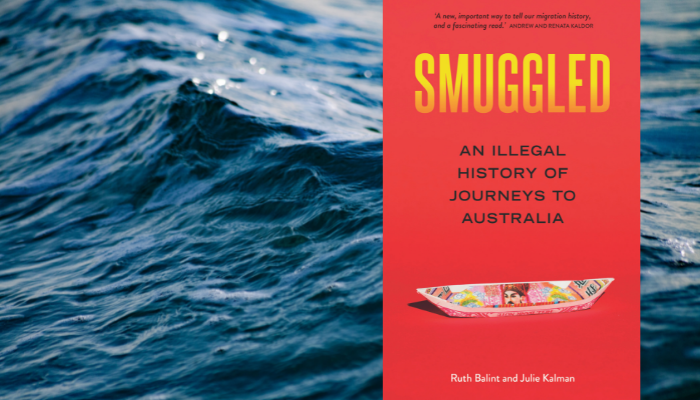Book Review: ‘Smuggled: An Illegal History of Journeys to Australia’ – Ruth Balint and Julie Kalman
As the European Union moves further towards Fortress Europe with migrant pushbacks and performative disdain for human dignity, ‘people smugglers’ also are in the frame. They now include parents “endangering the life of (their) child”, who can be jailed for 10 years, and passengers who put their hand on the tiller at some time during the voyage. As an island continent, a long way from the countries which generate refugees, a boat journey to Australia is arguably in more need of a ‘fixer’ than regions where porous and contiguous land borders allow some agency to seek immediate respite. Malcolm Turnbull knew their role was crucial when he said in 2014: “The fact is that if you want to stop the people smuggling business you have to be very, very tough.”. Both sides of Australian politics in more recent times have believed the “people smuggler” trope is a potent card to play in domestic politics. Perhaps the most egregious comment was Kevin Rudd’s in 2009 that “people smugglers are engaged in the world’s most evil trade and they should all rot in jail because they represent the absolute scum of the earth.” Yet for their own self-interest, politicians do not reproach family members and diaspora networks who often play a similar facilitative role.
However, is it possible that the primal and deep-seated anguish in the Australian psyche about ‘people smugglers’ is nowadays a less useful political tool? The boats have largely stopped, so the fear has lessened. Also, the neo-liberal language of the contractor/customer/service provider frames perspectives, as well as a greater tolerance of unregulated and informal businesses. This should make people less judgemental about the useful, honest examples of people smugglers, which are replete in the stories provided here. It may be that unpacking the people smuggler category by numerous examples might be the most effective way to respond to the demonisation which has unbalanced the debate.
The authors, history professors at UNSW and Monash University respectively, have a personal connection with the subject matter, through their own European Jewish families. Balint points out that some of the post-war Jewish refugees to Australia had to ‘smuggle’ themselves, in the sense of misrepresenting their identity, due to racially based restrictions, despite the government’s official policy of non-discrimination. (As an aside, contemporary policy itself gives incentives to break the rules when the goal posts are moved. The miserable allocation of 3,000 places – when a reputed 100,000 people have applied – within the existing Humanitarian quota for Afghan refugees, will displace refugees patiently waiting for many years to be selected around the world from camps, makeshift housing or worse. So much for an equitable and orderly process.)
Their interviews draw on the Jewish émigré experience to illustrate the various functions people smugglers provide, and to remember some of the WW2 heroes who issued visas to Jews in flight to save lives: Chiune Sugihara (the Japanese consul in Lithuania), Ho Feng-Shan (the Chinese consul-general in Vienna), Maurice Jacquet (the honorary Dutch consul in Lyons), Raoul Wallenberg (the Swedish diplomat in Hungary), Bronislaw Teicholz, (who distributed 15,000 official Swedish passes). The importance of this legacy is not forgotten, with the Melbourne-based Jews for Refugees campaign repeatedly reminding Treasurer Josh Frydenberg of the injunction which occurs 36 times in the Torah (the first part of the Hebrew Bible): ’Do not oppress the stranger for you yourselves were strangers in the Land of Egypt.’
Many non-European stories of refugee flight are also told here, from the Vietnam War, Hungary’s 1956 revolt, Afghanistan, Ethiopia, the Middle East, the Prague Spring of 1968, Burma. The book includes comments or stories from well-known Australians providing illustrations of the smuggler role: Munjed Al Muderis (the orthopaedic surgeon), Georges Mora, Les Murray, and actress and publisher Carina Hoang (her glossy illustrated book “Boat People: personal stories from the Vietnamese exodus 1975-1996” is extraordinary). A theoretical discussion between Behrouz Boochani, his translator and Claudia Tazreiter of the Forced Migration Research Network rounds out the book. After reading the book I still wonder why it’s subtitled an illegal history (?) of journeys rather than a history of illegal journeys – presumably a publisher’s hook to get attention.
Kevin Bain’s refugee reading guide is at Bayside Refugee Support.
